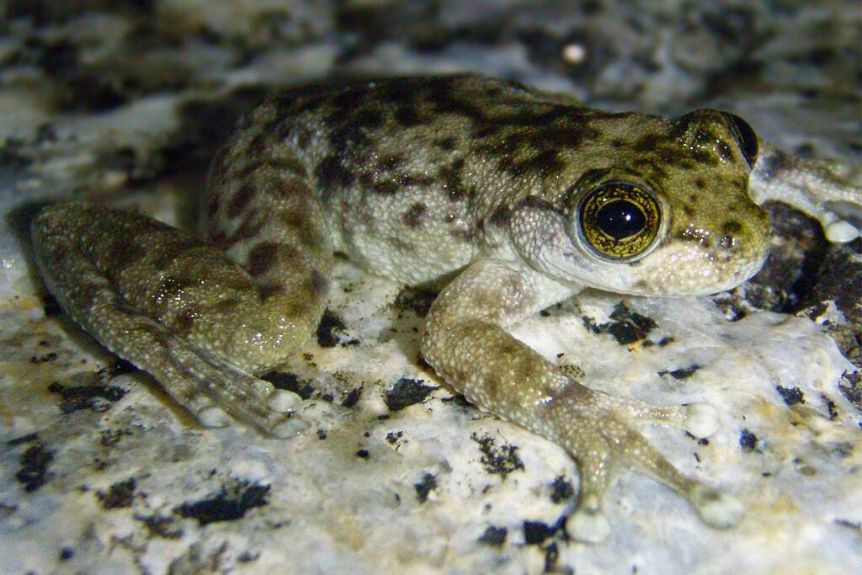Critter Corner – Little Waterfall Frog
#CritterCorner – The Little Waterfall Frog (Ranoida lorica) is a tiny, remarkable and critically endangered amphibian that has fascinated scientists and conservationists alike. Also known as the Armoured Frog or Armoured Mistfrog, this species, once thought to be extinct, has made a surprising comeback, defying the odds in the face of habitat loss and disease.
A Frog with Many Names
In addition to having multiple common names, the Little Waterfall Frog’s scientific name has changed over time due to taxonomic reclassification. Initially described as Litoria lorica, it has more recently moved to the genus Ranoidea, reflecting a deeper understanding of its evolutionary relationships. While Ranoidea lorica is now the accepted scientific name, Litoria lorica is still commonly used in older literature.
Either way, this tiny treefrog gets its name “lorica” from the Latin word for breastplate, referring to the small, black, spiny pads on the male’s chest and thumbs, which resemble protective armour. These spines, which are rare among frogs, help males grip females securely during mating.
Life in the Splash Zone
The Little Waterfall Frog is perfectly adapted to life in the spray zones of fast-flowing rainforest streams. Its mottled, earthy colouring helps it blend seamlessly with the granite boulders it calls home, while its strong toe pads give it a firm grip on slippery surfaces. Unlike many frogs, which prefer still water, this species thrives in the constant rush of cascading streams. Even its tadpoles have evolved to survive in this difficult environment, using a special suction-like disc on their heads to cling to rocks in the current!
A Species on the Edge
Despite its resilience, the Little Waterfall Frog faces serious threats and remains on the brink of extinction. It was once found across several rainforest regions, but in the early 1990s, populations plummeted due to a deadly fungal disease known as chytridiomycosis. For 17 years, no one could find it in the wild and scientists feared it was gone forever – until a small surviving population was rediscovered in 2008 on the Carbine Tableland. This tiny population is restricted to just 4 km of stream habitat.
The good news? Conservationists are working hard to protect this frog through habitat restoration and translocation programs. By creating additional populations in safe areas, scientists from James Cook University, Traditional Owners, like the Western Yalanji Aboriginal Corporation, and organisations like the Foundation for Australia’s Most Endangered Species (FAME) are giving this species a fighting chance.
From 2013 to 2015, a reintroduction program established a second frog subpopulation 4 km upstream. In 2023, 50 frogs were successfully relocated to a new Wet Tropics site to create a third subpopulation, and another 50 frogs joined them in 2024 to support this growing population.
Why Protecting This Frog Matters
The Little Waterfall Frog isn’t just another cute amphibian—it’s a key indicator species. Amphibians are highly sensitive to environmental changes, meaning their health reflects the health of the ecosystem. If these frogs disappear, it could signal deeper problems within the rainforest, affecting many other species that depend on these waterways.
Protecting this frog means preserving its rainforest habitat, reducing the spread of diseases like chytrid fungus, and ensuring clean, flowing streams remain part of the landscape. By saving the Little Waterfall Frog, we help protect an entire ecosystem.
Fun Facts About the Little Waterfall Frog / Armoured Mistfrog
- Missing!: This frog wasn’t seen for nearly two decades before being rediscovered in 2008.
- Master of Camouflage: Its blotchy skin mimics the look of wet rocks, making it almost invisible to predators.
- Tough Tadpoles: Unlike most frog larvae, its tadpoles cling to rocks in fast-moving water, staying safe from being washed away.
- A Silent Frog: Unlike many treefrogs, its call remains a mystery – no one has ever documented its vocalisation.
The Little Waterfall Frog’s story is one of survival against the odds, but it still desperately needs our help – without intervention it still has an extremely low chance of survival. By supporting conservation efforts and protecting rainforest habitats, we can ensure this tiny warrior continues to thrive for generations to come.
References
- https://amphibiaweb.org/species/1269
- https://www.aws.org.au/wp-content/uploads/2023/01/AWS_Magazine_Summer_2023_Mist_Frog-2.pdf
- https://www.dcceew.gov.au/sites/default/files/env/pages/3012fac8-dd75-4cfb-86af-15c6843710ad/files/litoria-lorica-listing.pdf
- https://bie.ala.org.au/species/https://biodiversity.org.au/afd/taxa/4b029404-d648-47a6-b35d-cf390b8bc55a
- https://www.environment.gov.au/biodiversity/threatened/species/pubs/1841-conservation-advice-13072017.pdf
- https://www.researchgate.net/figure/The-Armoured-Mistfrog-Litoria-lorica-was-believed-extinct-from-chytrid-fungus-disease_fig2_332132896
- https://www.fame.org.au/projects/establishing-armoured-mistfrog-populations
- https://eatlas.org.au/nerp-te/wt-jcu-endangered-rainforest-frogs-ecotonal-areas-3-3
- https://www.jcu.edu.au/news/releases/2013/october/endangered-frog-gets-new-lease-of-life
This article was written for Rainforest Rescue by Sian Bostrom – for more of Sian’s work, visit http://www.sianbostrom.com/
Want more good Rainforest news in your life?
Subscribe to our eNews | Follow us on Instagram | Like us on Facebook | Subscribe to our YouTube channel
Help Protect Rainforests Forever
Donate to Protect Rainforests Forever | Become a Rainforest Guardian | Partnership Options


